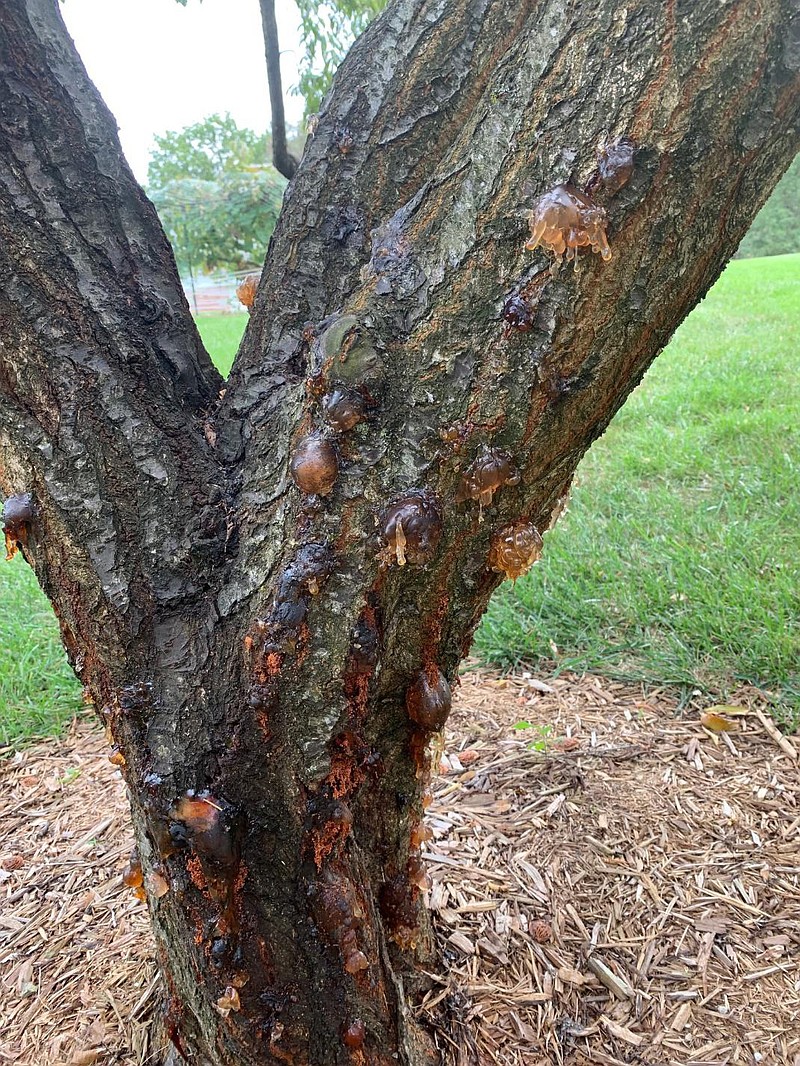Q. What is this stuff oozing out of the trunk of my plum tree? What should I do about it? (see photo)
A. That is the classic symptom of damage from the lesser peach tree borer, being the sap coming out of the holes created by the borers. If this pest is not controlled, your plum tree health could decline. In the publication (by University of Missouri Extension) "Fruit Spray Schedules for the Homeowner," the instructions are:
"Adult moths typically begin to emerge in mid-May (Mid-Missouri); apply weekly sprays during moth flight (through June). Larvae can become established only in damaged tissue (such as pruning wounds, cankered areas and sun-scalded bark). Once established, the larvae feed on growing bark and may enlarge the damaged area, often girdling the limb Direct sprays from ground level up the trunk and including the main scaffold limbs, wetting the bark thoroughly."
Two insecticides that are recommended and labeled for plums at Spectracide Triazide Inset Killer and Captain Jack's Deadbug Brew.
Q. I have a rose stem I got from a florist, and I would like to grow a plant from it. Is this possible? I like doing this kind of thing anyway, so if it doesn't work out, that's OK.
A. Yes, you could try this and you might succeed. Look up information on "making a softwood stem cutting of rose." If you like using YouTube, you probably can get an instructional video. Information I noted was a well-lit window is important, but avoid direct afternoon sun. Fall through winter is ideal as well, as this might take some time and is better if temperatures are cooler. Use of a rooting hormone will help your success but is not critical.
As for your rose selection, two things to consider. A "florist quality rose" is probably pampered in a greenhouse and may not be the best garden performer. Most production roses are also grafted onto a rootstock that improves its performance, so if your rose doesn't thrive, it could also be a poor performing root system.
Q. Can I still plant spring flowering bulbs like daffodils and tulips?
A. Probably, if not an outright yes. One wants them planted about a month before the ground freezes, and that often doesn't happen until well into December, if not almost January. Of course Missouri has erratic weather and one really doesn't know when that will be, but based on past years, I'd say to go for it, just get it done by Thanksgiving. Using last year as an example, it got cold quick in November, but the ground really didn't "freeze up." Then we got a warm spell in late December, lasting until early January. The big snowstorm insulated the ground so only after it melted and the really cold weather hit at the end of January, did the ground freeze up good.
Q. What are some easy and common perennial flower seeds I can sow now?
A. All of these can benefit from the cold and moist season to facilitate seed germination and emergence. Black-eyed Susan (Rudbeckia fulgida), Penstemon (Penstemon spp. and hybrids), Pincushion flower (Scabiosa spp. and hybrids), Prairie coneflower (Ratibida spp.), Purple coneflower (Echinacea purpurea) and Wild columbine (Aquilegia canadensis). Have the area you are going to seed reasonably clear of plants and plant litter/debris. After sprinkling on, just press the seed into the bare ground. No need to rake it in or bury in another way.

